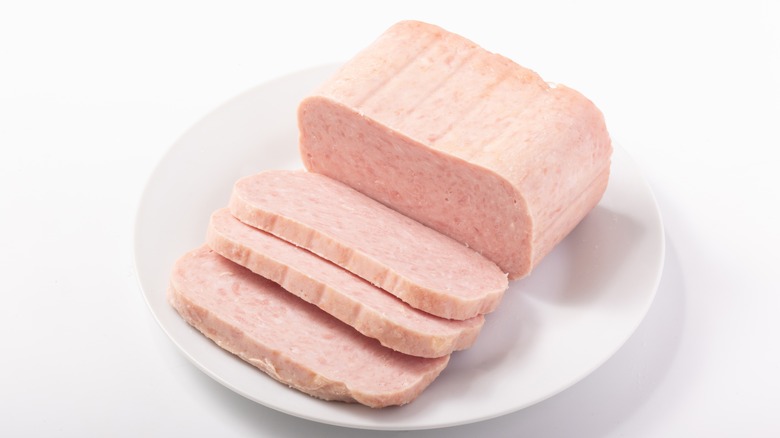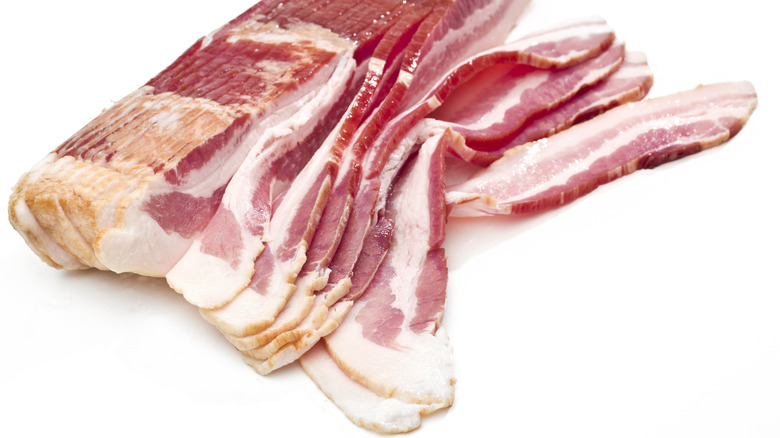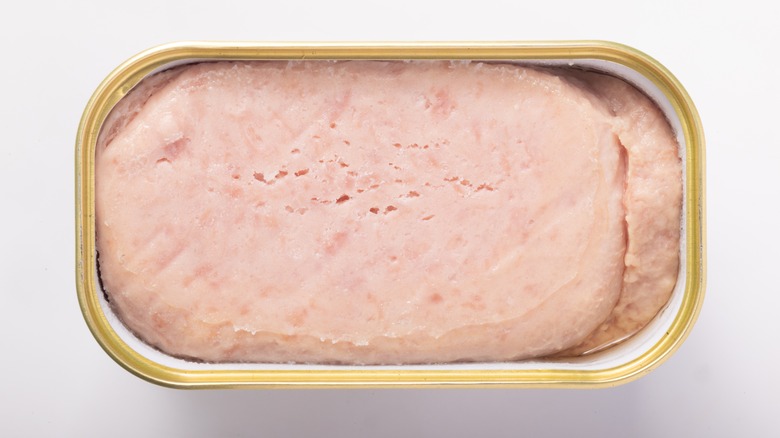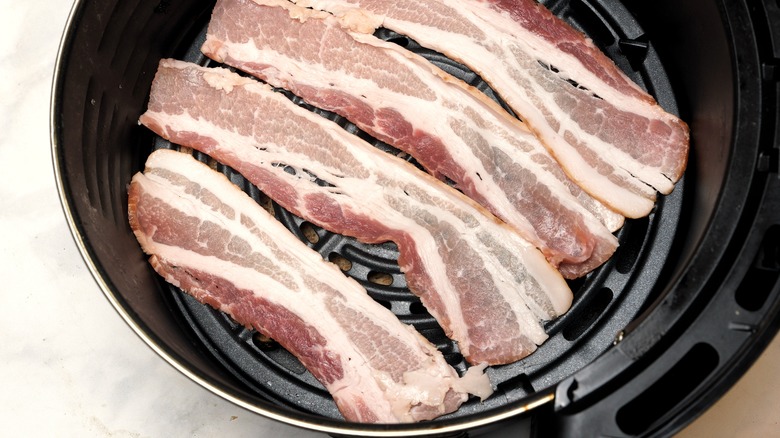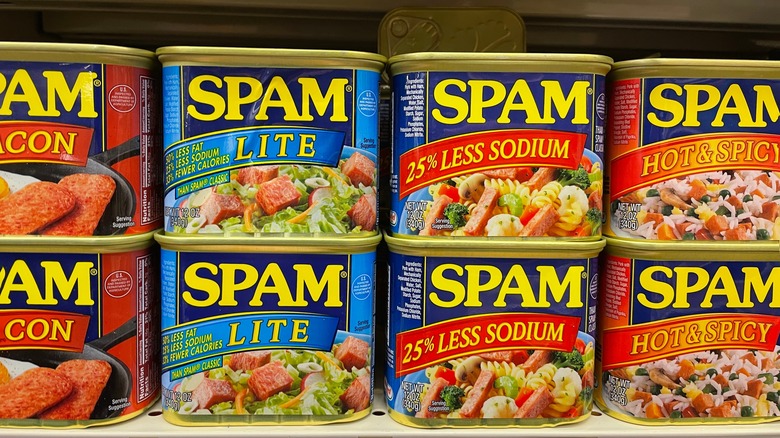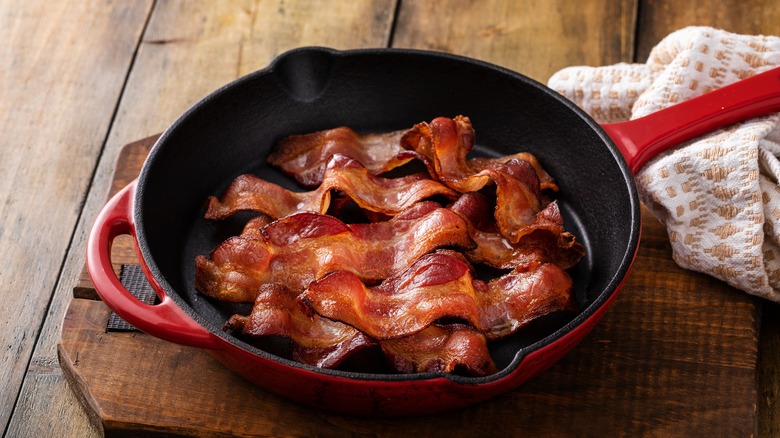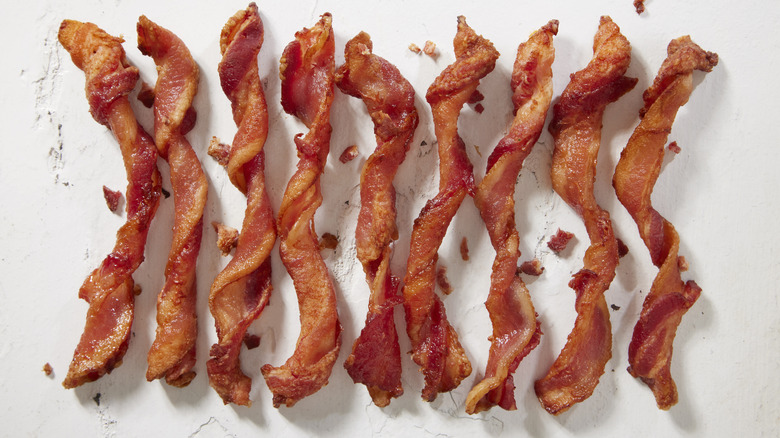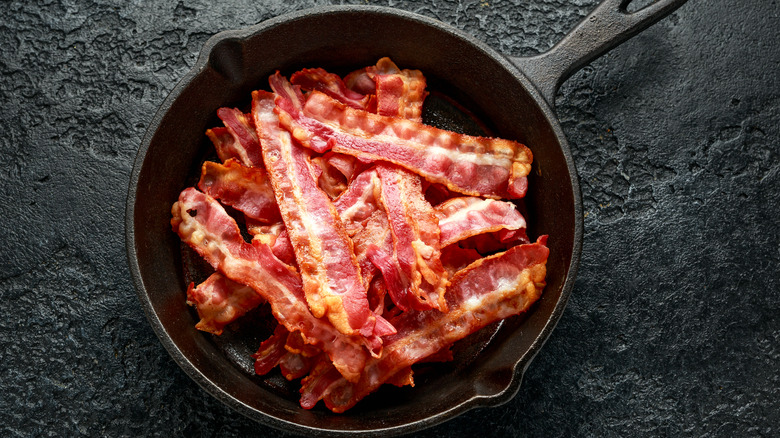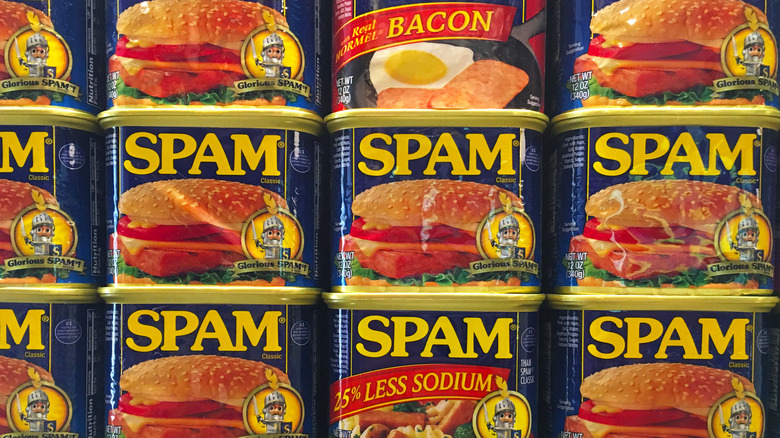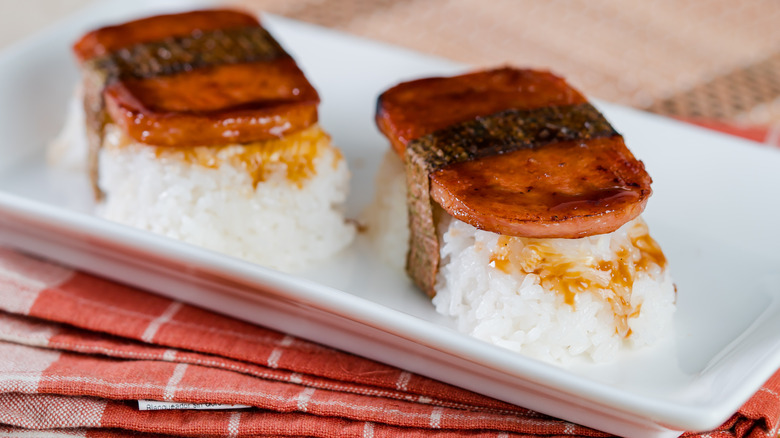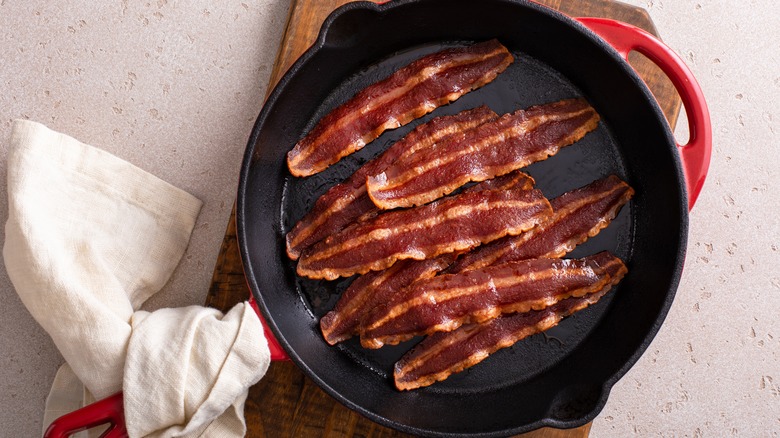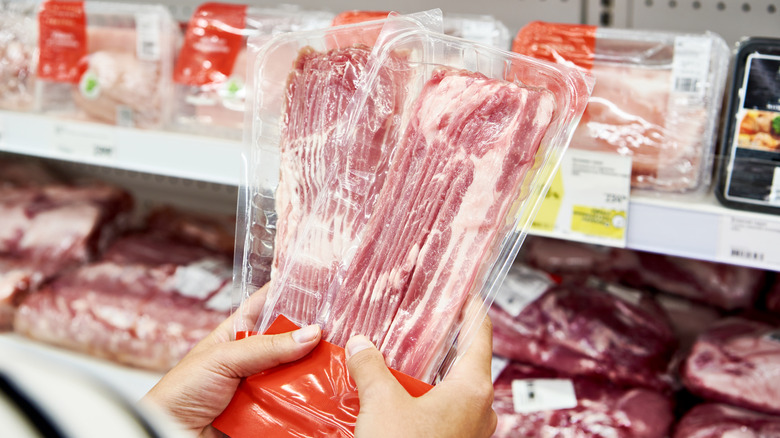Spam Vs Bacon: Everything You Need To Know
When it comes to cured pork, there are a number of options at your disposal, from pancetta to lomo, sausage to dry-cured ham. But two of the most beloved — and divisive — members of the category are Spam and bacon. And while both were created as a means to extend the shelf life of pork, they couldn't be more different.
Bacon has a long, illustrious history, with some tracing its origins back to 1500 B.C. when people in China began salting and curing pork belly to preserve meat. Soon, the process was adopted by Greeks and Romans. These days, you'll find bacon the world over. Spam, meanwhile, is a canned lunch meat that was invented by Hormel Foods in Austin, Minnesota, in 1937. Inexpensive and shelf-stable, the product was catapulted to popularity in times of scarcity, proving to be a cheap source of protein during both the Great Depression and World War II. These days, it's available in 15 different versions, including ones infused with maple flavor, teriyaki sauce, or spicy jalapeño peppers.
Both bacon and Spam are salty, porky, and delicious — but they are also quite distinct from one another. Here's everything you need to understand about the differences between these two products.
Spam comes from the leg and shoulder of the pig
Spam is a reconstituted pork product, but it's anything but fake meat. It's made with two different cuts of pork — shoulder and ham — which both lend loads of flavorful fat to the finished product.
Ham may be most familiar as a deli meat, but it's actually the name of a particular cut of pork hailing from the back thigh and rear of the pig. But in addition to ham, Spam does rely heavily on pork shoulder, which, back in 1937 when the product was invented, was seen as a low-quality cut of meat. These days, however, pork shoulder is quite sought-after, especially for slow-cooked braises and dishes like pulled pork.
Some claim that the name Spam is a blending of the words spiced and ham, though in reality, Spam is not spiced. Given the actual ingredients in Spam, another theory of its name — that it's an acronym of Shoulder of Pork And Ham — holds far more water. In reality, however, the name, by most accounts, predates the development of the recipe and is credited to a winning entry from a contest.
Bacon usually comes from the belly of the pig
The word "bacon" refers to a number of different cuts and styles of cured pork product, from Canadian bacon, made with pork loin, to English back bacon, made with a cut that marries both loin and belly. But in the United States, more often than not, the word "bacon" refers to a cut of smoked pork belly. Pork belly is a particularly fatty cut, with some estimates noting it's about 90% fat and just 10% meat. But all that fat translates to loads of flavor. Bacon in this style is typically cut fairly thinly and cured in nitrates, nitrites, and salt. It's then usually smoked over hickory or applewood for loads of even more flavor. Some bacon is also flavored with maple or apples or coated in spices like black pepper.
That said, not all American-style bacon is necessarily made with pork belly. Some butchers will make bacon from the loin, jowl, shoulder, or side of the pork. Each of these types of bacon will have its own flavor and texture.
Spam is reconstituted and made with stabilizers
While both bacon and Spamare cured, the latter undergoes additional processing. In addition to pork ham and shoulder, Spam contains five other ingredients: salt, water, potato starch, sugar, and sodium nitrite. The salt and sugar add flavor but also serve to preserve the meat, which is the main role of the sodium nitrite, a common preservative in cooked and cured meat products. The potato starch is a more recent addition, joining the company's classic recipe in 2001 with the goal of minimizing the thick gelatin layer that would typically form over the top of the canned meat.
To make Spam, the pork is first ground, and then it's mixed with the other ingredients for 20 minutes. The resulting combination is fairly homogenous, and when it's vacuum-sealed in cans and cooked for three hours, it sets up into a solid, even mass of pork that's easy to slice and enjoy.
Bacon retains its original form
There's a reason the Brits call American bacon "streaky bacon." Since pork belly is fairly fatty, this cut is streaked with strips of pink meat and strips of white fat. As the meat cooks, the fat in the bacon melts, providing ample cooking fat to turn the meaty part nice and crispy.
Bacon is most typically purchased in slices of a variety of thicknesses, but that's not the only way you'll find this cut sold. You can also find slab bacon, which is sold unsliced and typically also sports a hard rind, which protects the tender meat within. Most experts recommend trimming this rind before enjoying the bacon, as it can tend to be too tough, making the eating experience anything but enjoyable. (Since this task can be time-consuming and difficult if you don't have a sharp knife, consider asking your butcher to remove the rind for you.) Bacon can also be purchased in lardons or small matchsticks that are perfect for tossing into salads or pasta dishes.
Spam comes in a variety of different flavors
While it's unlikely that the brand name Spam comes from a reference to spiced ham, those looking for more of a flavor kick than the salt and sugar used to season the original product need not look far. Spam comes in several different varieties, the vast majority of which are seasoned with other ingredients ranging from hickory smoke to paprika, jalapeño to teriyaki sauce. There is one Spam flavor designed to emulate Filipino tocino, a cured pork product with a sweet-and-savory glaze that's spiked with anisette. Another Spam variety features the rich, sweet flavor of maple.
And that's not all. For those who'd rather their Spam be poultry based, there's a variety made with turkey that boasts a flavor of a roast dinner. Some versions, including those with less fat and sodium, contain mechanically separated chicken in addition to pork. And for those who can't choose between Spam and bacon, there's a type made with real Hormel bacon and rendered bacon fat for even more porky flavor. Limited edition flavors have also occasionally graced the Spam world, including a pumpkin spice version and one that emulates all the Christmassy flavors of figgy pudding.
Bacon is cured and then seasoned with smoke
Bacon has found its way these days into many a dish, from breakfast hand pies to the many twists on a BLT sandwich to desserts like chocolate bacon cupcakes, and that's no surprise. It's delicious. With a lovely richness thanks to the naturally high fat content of pork belly, bacon gets even more help in the flavor department thanks to two different processes it undergoes before it makes it to your table.
During the first step, bacon is typically dry-cured with salt and other seasonings, which may or may not include sugar. The process involves coating the bacon in the seasonings and allowing it to rest for several days. Some bacon may be wet-cured, which as its name suggests involves submerging the pork belly in a liquid to cure it. That method became popular through the world's first commercial bacon processing plant that opened in Wiltshire, England, back in the late 18th century. (The plant's process involving a special brine solution to preserve bacon became known as the Wiltshire Cure.) That said, dry-curing is a far easier method and, according to many, gives bacon a more robust flavor. It's no wonder that it's the more common method these days.
However it's cured, bacon typically undergoes a second process that infuses it with even more flavor: smoking. The type of wood chosen adds loads of flavor to the finished product; favorites include applewood, hickory, or cherrywood.
Bacon contains more fat than Spam
While Spam and bacon are certainly both delicious, let's get one thing straight: Neither is the most nutritious of options. One 2-ounce serving of the original Spam variety contains 180 calories and just a handful of micronutrients like zinc, potassium, iron, and copper. It also boasts 16 grams of fat.
Bacon, on the other hand, has about 263 calories in a 2-ounce portion with an estimated 19.6 grams of fat. While bacon also contains potassium and essential B vitamins, selenium, and phosphorous, you'd be hard-pressed to find any cardiologists calling it a health food.
That said, keto dieters are proponents of both bacon and Spam, noting that they're low in carbs and high in fat. When it comes to bacon specifically, it's important to seek out good-quality brands without any added carbs in the form of sugars if you want to take advantage of the low-carb benefits of this high-fat snack. And if you're looking for a lower-fat option that retains some of the tasty flavor of bacon, turkey bacon is an option, with some brands containing half as much fat as pork does.
Bacon contains more sodium than Spam
Both bacon and Spam are pretty high in salt, with a 2-ounce portion of Spam containing 790 milligrams of sodium and the same amount of bacon containing about 948 milligrams. And while the human body does indeed need some sodium to help with nerve and muscle function, experts say 500 milligrams per day is more than enough. Consuming too much sodium on the other hand, can contribute to health issues including high blood pressure, stroke, and heart disease. Federal guidelines recommend adults consume no more than 2,300 milligrams of sodium each day. That's the equivalent of one teaspoon of table salt.
If you want to indulge in Spam or bacon without spiking your sodium levels, there are thankfully some lower-sodium options. Low-sodium bacon is often made with turkey rather than pork, though there are some pork belly iterations, including Great Value Hickory Smoked Lower Sodium Bacon, which boasts just over 560 milligrams of sodium per 2 ounces. On the Spam side of things, meanwhile, the less sodium iteration has 580 milligrams per 2-ounce portion.
Bacon is slightly lower in carbs than Spam
Pork is naturally devoid of carbohydrates, but the processed nature of both bacon and Spam means they're not completely carb-free. The presence of sugar in Spam does mean the original variety contains 1 gram of carbs per 2-ounce serving. Bacon, meanwhile, contains less than a gram of carbs per 2-ounce serving on average, making it a slightly better choice for low-carb diets.
Of course, if you're trying to limit your carbs for health reasons, you'll want to read the nutritional information carefully. Not all bacon is created alike. Some bacon is glazed in maple syrup or seasoned with other sugars for a slightly sweet flavor that definitely ups the carbs. Certain flavors of Spam, meanwhile, contain more carbohydrates than the classic, like the maple version with 3 grams of carbs per 2-ounce serving or the teriyaki version with 5 grams of carbs per serving. It's also important to bear in mind how the meats are being prepared and used. Spam musubi is a recipe that calls for the meat to be glazed in a sweet sauce, which contributes to a higher carb count, and bacon may be low-carb, but a BLT on toast certainly is not.
Spam is more shelf-stable than bacon
Curing bacon and other pork products began as a method of extending the shelf life of perishable pork. Curing bacon takes advantage of the preservation properties of salt and nitrates to keep it fresher longer. Smoking it over wood increases its shelf life it even further. As a point of comparison, unopened cured bacon can last up to two weeks in the fridge; uncured pork belly, meanwhile, should be cooked and consumed within two days.
But while bacon was designed to last, that ability is nothing when compared with shelf-stable Spam. Tins of Spam generally have a best-by date of around three years based on when they were manufactured, but they don't have an expiration date, meaning that if they're stored in ideal conditions, they can safely be consumed indefinitely. (Safely doesn't mean deliciously, however, as one former resident of Sarajevo found. People there had received Spam as part of the humanitarian aid packages and were eating it 20-plus years past its best-by date.)
Spam is particularly beloved in Hawaii
Spam's shelf-stable nature catapulted it to fame in regions with food instability, including Guam and the Philippines, where it has become a beloved element of local cuisine. This holds true in Hawaii, too, where the canned pork product first appeared during World War II thanks to American GIs. Soon, locals embraced the canned meat, including it in all sorts of recipes like Spam fried rice, Spam wontons, and Spam loco moco.
"It is such an iconic item," Scott Gamble, vice president of L.H. Gamble Company, the Spam supplier for all of Hawaii, tells USA Today in 2023. "It kept well over time. It was very versatile."
Indeed, Spam is an integral part of Hawaiian culture and cuisine these days. Hawaiians consume about 7 million cans of Spam a year. And there's perhaps no dish more iconic than Spam musubi, aka Spam sushi, which consists of a piece of Spam caramelized in a sweet and savory sauce, paired with white rice, and wrapped in nori or dried seaweed. The dish is so beloved that National Spam Musubi Day was created in 2021 and is now celebrated every August 8.
Spam is ready to eat, but bacon needs to be cooked
While there are loads of recipes that see Spam caramelized or sautéed and added to a variety of dishes like mac and cheese or breakfast sandwiches, one major benefit of this product is that it can be consumed straight out of the can. This is because cans of Spam are vacuum-sealed and cooked for three hours to preserve the meat contained inside.
But while bacon may spoil less quickly than uncured raw meat, it's still not recommended that you eat bacon without cooking it. Uncooked bacon may contain food-borne parasites like toxoplasmosis, trichinosis, or tapeworms, all of which can cause digestive distress. Bacon is traditionally cooked in a pan on the stovetop, but these days most pros prefer cooking bacon on a sheet pan in the oven, which results in more evenly cooked bacon and less mess on the stovetop. Either way, be sure to save the bacon fat, which is a versatile ingredient in its own right.
Spam is slightly cheaper, pound for pound, than bacon
Both Spam and bacon are relatively inexpensive sources of protein, but Spam is slightly cheaper, at about $4.45 per pound as compared to bacon, which retailed for an average of $6.89 per pound in November 2023. The price of bacon fluctuates over time, but overall, it's been increasing fairly steadily since 2009, when a pound of bacon cost an average of $3.60.
One contributing factor to this change — and to the discrepancy — may well be the increasing popularity of specialty bacons, specifically those cured without nitrites and nitrates. As people ascribe more and more to high-fat, low-carb diets like paleo or keto, the market demand for less-processed bacons eschewing added preservatives and carbs has positively skyrocketed. Given the demand for these bacons, they tend to be more expensive than run-of-the-mill brands. This may well have contributed to the rising cost of bacon in general.

